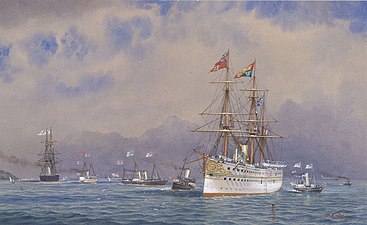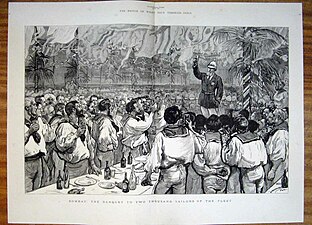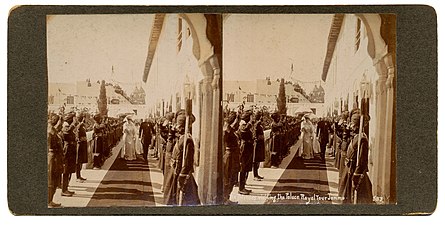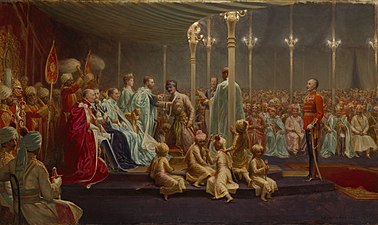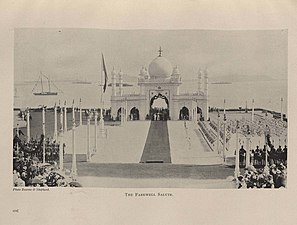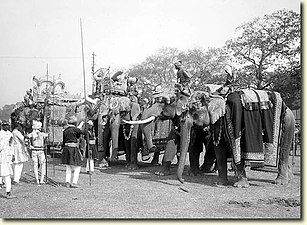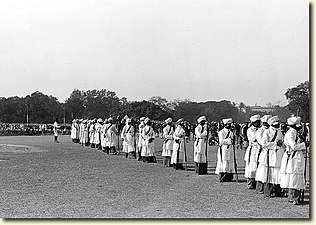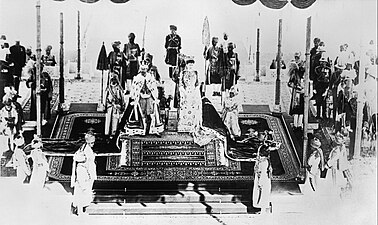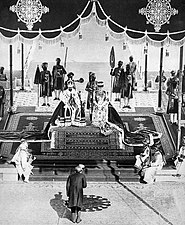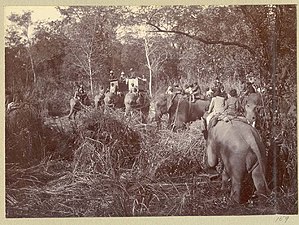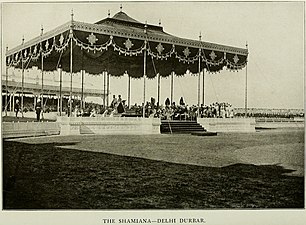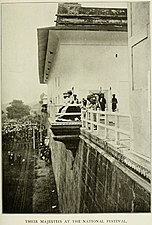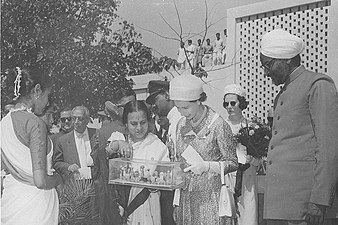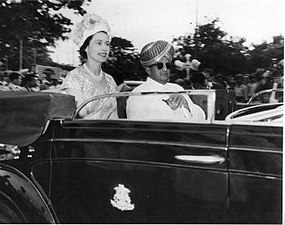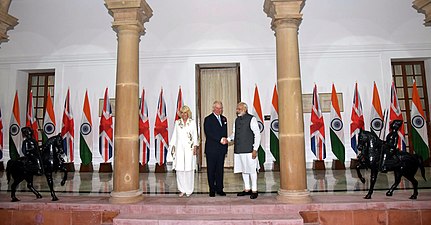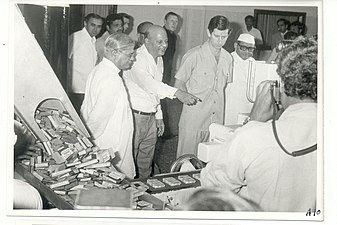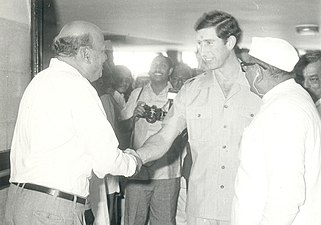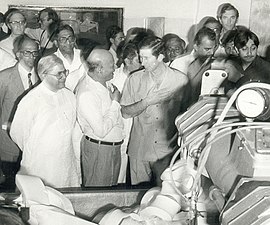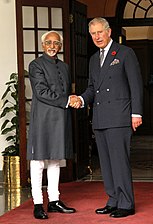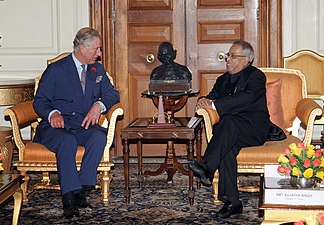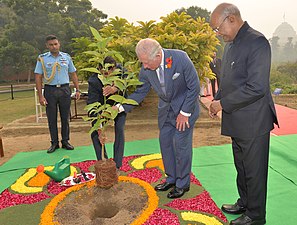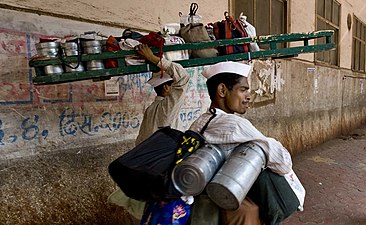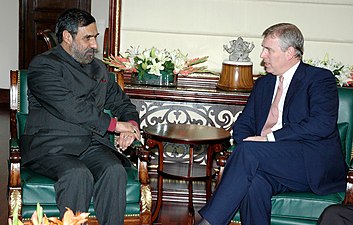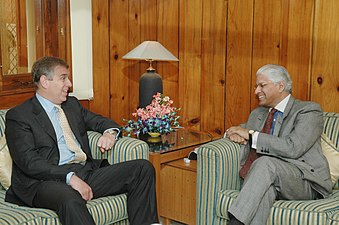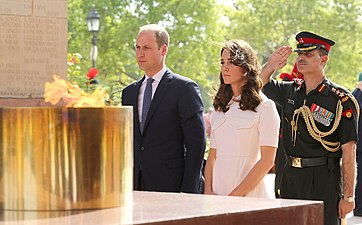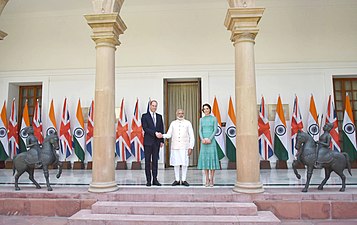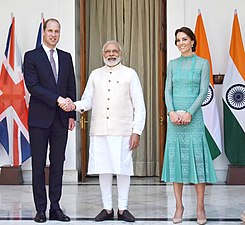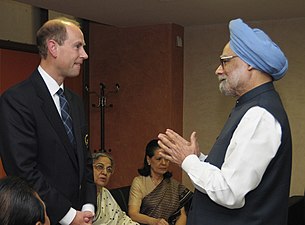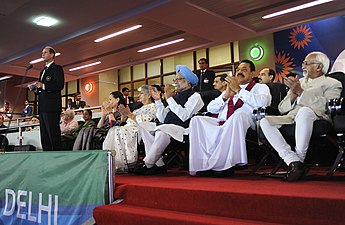User:Peter Ormond/Royal tours of India by the British royal family
- 1875: Bertie
- 1905: George
- 1911: George
- 1920: David
- 1959: DoE
- 1959: P Alex
- 1961: EIIR[1]
- 1983: EIIR
- 1984: A, PR
- 1997: EIIR
- 2010: Chuck
- 2010: Ed Wsx
- 2016: W&C[2][3][4][5][6][7][8]
Royal tours of India by the British royal family have been taking place since 1875, and continue into the 21st century. George V is the only reigning Emperor of India to have set foot on Indian soil; he did so on 2 December 1911. His granddaughter Elizabeth II toured the Republic of India on three separate occassions. Other members of the royal family have also paid visits.
19th century[edit]
The first member of the Royal Family to visit India was Bertie, Prince of Wales (later King-Emperor Edward VII), son of Queen Victoria, Empress of India, in 1875.
In October 1875, the Prince of Wales set off on a four-month tour of the Indian subcontinent, visiting over 21 localities, which today encompass India, Sri Lanka, Pakistan and Nepal, before returning home in May 1876.[1][2]
The Prince of Wales departed for his tour on 11 October 1875. From London, he travelled by rail and ferry to the port of Brindisi in southern Italy, where he boarded HMS Serapis, the ship that was to take the Prince and his entourage to India.
The Prince made brief stops at Athens, Cairo and Aden on the way to India, where he met King George I, Khedive Isma'il Pasha, and Sultan al-Fadl III ibn `Ali al-`Abdali, respectively. The route to India made use of the Suez Canal, which had opened in 1869. The canal had reduced the journey from Britain to India by 4,500 miles.[3]
On 8 November, after more than three weeks at sea, the Prince of Wales arrived at the port of Colaba in Bombay. To mark the Prince’s arrival in India, royal gun salutes were held in major cities across the Indian subcontinent. In Bombay, the Prince hosted his first reception for the Indian rulers. Here he adopted Indian court customs such as offering paan (shavings of betel-nut, various seeds and spices, and lime-paste wrapped in a betel-leaf) and attar (perfume) to welcome them.[4][5]
During the Prince’s first month on the Indian subcontinent he also visited Poona and Baroda.[4][6]
The second leg of the Prince of Wales’s tour around the Indian subcontinent was predominantly by ship. The Prince departed Bombay on 25 November and sailed toward Ceylon (Sri Lanka). The HMS Serapis arrived at the port of Colombo in Ceylon on 1 December. Here the Prince was welcomed by William Henry Gregory, Governor-General of Ceylon, and members of the Tamil community. In Ceylon the Prince also visited Kandy, a former capital of various kingdoms in Ceylon.
From Ceylon the Prince sailed to the southern tip of India. He arrived at Tuticorin (Thoothukudi) on 10 December. On 18 December, the Prince made his way to the British capital of India, Calcutta (Kolkata) and arrived there on 23 December.[7]
The Prince visited the Meenakshi Amman Temple on 11 December 1875 and was sprinkled with gold dust as he entered the temple complex through an impressive gateway, or gopura.[8]
When the Prince arrived at Calcutta an impressive reception was organised to welcome him to the city. Pavilions were erected on the muddy banks of Prinsep's Ghat and decorated with white and gold pillars wreathed with garlands of roses and banners. The Prince was met by Viceroy Northbrook and several of the Maharajas who had not been able to meet him in Bombay. In this watercolour, Ranbir Singh Maharaja of Kashmir is shown greeting the Prince.[9]
Queen Victoria issued a warrant that authorised the Prince of Wales to hold an investiture of the Order on New Year's Day.
This watercolour shows the installation of the Maharaja of Jodhpur as a new Knight Grand Commander. The Raja of Jind and Maharaja of Panna were also invested during the ceremony. [10]
The Prince met with several Indian rulers at Government House, in Calcutta.[11]
From Calcutta, the Prince visited Benares (Varanasi), Lucknow, Delhi and Lahore, using the extensive rail networks that had connected many parts of India from the mid-nineteenth century. The Prince himself opened a new railway bridge for the Punjab Northern State Railways in Wazirabad (now in modern-day Pakistan), which crosses over the River Chenab.[12]
In the final months of his tour, the Prince visited Agra, Gwalior, Jaipur, Nepal and Indore. An important aspect of the tour was to make connections with the rulers of India, many of whose lineages had been established for centuries. The Prince received numerous invitations from Indian rulers to visit their palaces and states, providing him with opportunities to learn more about them.
The Prince visited Gwalior as a guest of Maharaja Jayaji Rao Scindia, arriving on 31 January. He stayed at the Maharaja’s newly built palace, Jai Vilas Mahal. Another state visited by the Prince was Jaipur. He arrived in the city on 4 February 1876 and was welcomed by Maharaja Ram Singh II. They then travelled through Jaipur on elephant-back, their route lit by torchlight.[13]
The Prince of Wales arrived at Agra on 25 January.[14]
Here, the Prince of Wales was so taken by the Taj Mahal that he visited it twice, once when it was lit by moonlight.[15]
From Indore, the Prince of Wales travelled back to Bombay, where the HMS Serapis waited to sail back to England. The Prince departed India on 13 March, after travelling the length and breadth of the Indian subcontinent and meeting more than 90 Indian rulers.
The exhibition of the Prince's gifts from India travelled to ten locations: South Kensington, Bethnal Green, Paris, Edinburgh, Glasgow, Aberdeen, York, Nottingham, Copenhagen and Penzance. In England and Scotland alone, more than 2.5 million visitors went to see them.[16]
-
The Prince of Wales entering the Solent on his return from India, on board HMS Serapis, 1876
-
The Prince of Wales' tour- a diary in India; with some account of the visits of His Royal Highness to the courts of Greece, Egypt, Spain, and Portugal (IA princeofwalestou00russ)
-
Bombay - The Banquet to Two Thousand Sailors of the Fleet
20th century[edit]
-
The Royal visit to India and Burma by the Prince and Princess of Wales in 1905-1906
-
Bikaner Camel Corps Royal Tour in 1905-06
-
The Princess of Wales visiting the royal tour, Jammu in 1905-06
-
Investiture of the Star of India
-
His Imperial Majesty, preceded by the Royal Standard
-
King George V on Elephant in India
-
Farewell Salute to George V
-
King George V and Queen Mary in Calcutta (2)
-
King George V and Queen Mary in Calcutta (1)
-
India Before the First World War; George V and Queen Mary at Delhi Durbar Q107150
-
George V at Police Review
-
George V passing out of the Delhi Red Fort
-
His Imperial Majesty's shoot in Nepalese Terai, December 1911 50
-
The Nizam of Hyderabad pays homage to the king and queen at the Delhi Durbar
-
King George V Hunting in Nepal (18)
-
Writing on the Gateway of India
-
Durbar Port Said stopover 1911
-
The King-Emperor's Chobdars
-
An Indian Camel Corps
-
The Reception at Bombay
-
The Shamiana of Darbar
-
Their Majesties at the National Festival (2)
-
The Darshan, post Delhi Darbar, 1911
-
Edward, Prince of Wales in Calcutta
-
BellaVistaPalast-DrawingRoom Hyderabad
21st century[edit]
-
Queen Elizabeth at Durgapur
-
Jcrw1
-
Camilla, Duchess of Cornwall with Peter McLaughlin in The Doon School
-
The Prime Minister, Shri Narendra Modi with Their Royal Highness, the Prince of Wales and the Duchess of Cornwall, at Hyderabad House, in New Delhi on November 08, 2017 (2)
-
The Duke and Duchess of Cambridge met cricket legends Sachin Tendulkar and Dilip Vengsarkar at the Oval Maidan in Mumbai (26337321926)
-
Narendra Modi's gifts to Her Majesty Queen Elizabeth II, of the United Kingdom, in London on November 13, 2015. The photograph shows February 24, 1961, Her Majesty visiting the Atomic Energy Centre at Trombay
-
Narendra Modi's gifts to Her Majesty Queen Elizabeth II, of the United Kingdom, in London on November 13, 2015. The photograph shows January 31, 1961; Ahmadabad. Her Majesty visiting Sabarmati Ashram
-
Narendra Modi's gifts to Her Majesty Queen Elizabeth II, of the United Kingdom, in London. The photograph shows February 19, 1961; Chennai. Her Majesty cutting a cake to celebrate the first birthday of Prince Andrew
-
Narendra Modi's gifts to Her Majesty Queen Elizabeth II, of the United Kingdom, in London. The photograph shows February 25, 1961; Varanasi. Her Majesty riding an elephant in a procession from Nandesar Palace to Balua Ghat
-
1980 His Royal Highness The Prince of Wales HM Dalaya visits Amul
-
1980 His Royal Highness The Prince of Wales HM Dalaya visits Amul 2
-
1980 His Royal Highness The Prince of Wales with HM Dalaya visits Amul 3
-
Pratibha Devisingh Patil, the former President of India, Dr. A.P.J. Abdul Kalam, the Prince of Wales, Prince Charles, his wife Duchess of Cornwall Camilla Parker, the Prime Minister, Dr. Manmohan Singh
-
The Prince of Wales, Prince Charles reads out the message of Queen Elizabeth on her behalf during the opening ceremony of the 19th Commonwealth Games 2010-Delhi, at Jawaharlal Nehru Stadium, in New Delhi on October 03, 2010
-
The Prince Charles of Wales meeting the Vice President, Shri Mohd. Hamid Ansari, in New Delhi on November 08, 2013
-
The Prince Charles of Wales meeting the President, Shri Pranab Mukherjee, at Rashtrapati Bhavan, in New Delhi on November 08, 2013
-
President Ram Nath Kovind and Prince of Wales planting a tree
-
Mumbai Dabbawala or Tiffin Wallahs- 200,000 Tiffin Boxes Delivered Per Day
-
The Prince Andrew, Duke of York, meeting the Union Minister of Commerce and Industry, Shri Anand Sharma, in New Delhi on March 10, 2010
-
The Duke of York, Prince Andrew calls on the Minister of State for Industry Dr. Ashwani Kumar, to discuss bilateral trade and investment, in New Delhi on October 30, 2006
-
The Duke and Duchess of Cambridge Prince William and Kate Middleton paying homage to the martyrs, at Amar Jawan Jyoti, India Gate, in New Delhi on April 11, 2016
-
The Prime Minister, Shri Narendra Modi with the Duke and Duchess of Cambridge Prince William and Kate Middleton, at Hyderabad House, in New Delhi on April 12, 2016 (1)
-
The Prime Minister, Shri Narendra Modi receives the Duke and Duchess of Cambridge Prince William and Kate Middleton, at Hyderabad House, in New Delhi on April 12, 2016 (1)
-
The Prime Minister, Shri Narendra Modi receives the Duke and Duchess of Cambridge Prince William and Kate Middleton, at Hyderabad House, in New Delhi on April 12, 2016
-
Prince Edward, Earl of Wessex being received by a senior officer of the Organising Committee Commonwealth Games 2010 Delhi, on his arrival at Jawaharlal Nehru Stadium
-
Prince Edward, Earl of Wessex with the Prime Minister, Dr. Manmohan Singh, at the closing ceremony of the XIX Commonwealth Games 2010-Delhi, at Jawaharlal Nehru Stadium, in New Delhi on October 14, 2010
-
Prince Edward, Earl of Wessex addressing at the closing ceremony of the XIX Commonwealth Games 2010-Delhi, at Jawaharlal Nehru Stadium, in New Delhi on October 14, 2010
-
Mahinda Rajapaksa, Prince Edward, Earl of Wessex, the Vice President, Shri Mohd. Hamid Ansari, the Prime Minister, Dr. Manmohan Singh and the President, CGF
- ^ https://www.rct.uk/collection/themes/trails/the-prince-of-waless-tour-of-india-in-1875-6
- ^ https://www.rct.uk/collection/themes/exhibitions/splendours-of-the-subcontinent-a-princes-tour-of-india-1875-6/the-0
- ^ https://www.rct.uk/collection/themes/trails/the-prince-of-waless-tour-of-india-in-1875-6/en-route-to-india
- ^ a b https://www.rct.uk/collection/themes/trails/the-prince-of-waless-tour-of-india-in-1875-6/first-steps-in-india
- ^ https://www.rct.uk/collection/themes/trails/the-prince-of-waless-tour-of-india-in-1875-6/state-reception-of-native
- ^ https://www.rct.uk/collection/themes/trails/the-prince-of-waless-tour-of-india-in-1875-6/arrival-of-the-prince-of-wales
- ^ https://www.rct.uk/collection/themes/trails/the-prince-of-waless-tour-of-india-in-1875-6/along-the-coasts-of-india-and-sri-lanka
- ^ https://www.rct.uk/collection/themes/trails/the-prince-of-waless-tour-of-india-in-1875-6/prince-of-wales-tour-of-india
- ^ https://www.rct.uk/collection/themes/trails/the-prince-of-waless-tour-of-india-in-1875-6/reception-of-the-prince-at
- ^ https://www.rct.uk/collection/themes/trails/the-prince-of-waless-tour-of-india-in-1875-6/the-grand-chapter-of-the-star
- ^ https://www.rct.uk/collection/themes/trails/the-prince-of-waless-tour-of-india-in-1875-6/reception-of-the-begum-of
- ^ https://www.rct.uk/collection/themes/trails/the-prince-of-waless-tour-of-india-in-1875-6/travelling-inland
- ^ https://www.rct.uk/collection/themes/trails/the-prince-of-waless-tour-of-india-in-1875-6/visit-to-the-indian-courts
- ^ https://www.rct.uk/collection/themes/trails/the-prince-of-waless-tour-of-india-in-1875-6/arrival-of-the-prince-at-agra
- ^ https://www.rct.uk/collection/themes/trails/the-prince-of-waless-tour-of-india-in-1875-6/the-taj-at-agra-garden-view
- ^ https://www.rct.uk/collection/themes/trails/the-prince-of-waless-tour-of-india-in-1875-6/farewell-to-india

